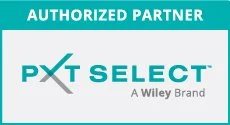Could you use easy-to-understand information about the candidates you are considering for key roles and get applicable questions to ask to strengthen your interviews? Meet PXT Select™! This assessment helps make the very human decisions about hiring simpler and smarter. It is a powerful selection assessment that measures a candidate’s cognitive abilities, behaviors, and interests.
PXT Select measures a candidate’s thinking style, behavioral traits, and interests: three areas that impact an individual’s approach to situations in the workplace.
Once the candidate takes the PXT Select Assessment, you have access to a suite of reports you can use over time to help select, onboard, coach, and develop your employees:
o Comprehensive Selection Report. Is the candidate a good fit? This powerful report helps you make smarter hiring decisions with confidence. Featuring dynamic interview questions and tips on “what to listen for” with each candidate, this report gives you a meaningful edge in your hiring process.
o Comprehensive Selection Report: Sales*. This powerful report helps identify a candidates fit to a role. It features dynamic interview questions to help strengthen the overall hiring process. With a focus on sales, this report highlights critical sales practices and describes how a candidate might demonstrate them, helping you select the right salespeople for your organization.
o Multiple Positions Report. What’s the best fit for a particular individual? Compare a candidate or employee to multiple jobs in your organization.
o Multiple Candidates Report. Make hiring decisions with ease. Compare multiple candidates for a single position.
o Team Report. See how a potential candidate fits an existing team, or address your current team’s dynamic and strengths.
o Manager-Employee Report. Discover how a manager and employee can work more effectively together.
o Individual’s Feedback Report. Candidates can learn from PXT Select, too! This narrative report doesn’t reveal scores and is perfectly safe to share with applicants.
o Individual’s Feedback Report: Sales*. This participant report offers personalized feedback to the candidate or employee using common sales language and does not include critical sales practices.
o Individual’s Graph. Are you more of a visual person? The graph illustrates a candidate’s results that you can view at a glance.
o Coaching Report. Wish you had coaching advice tailored to each employee? This report gives you exactly that and more!
o Coaching Report: Sales*. This report provides tailored coaching guidance giving managers personalized tips and strategies to develop their sales team members.
o Performance Model Report. Understand the range of scores and behaviors for the position you’re trying to fill. Learn about the ideal candidate for that role. *sales-focused report available.
DM me for a demo!



